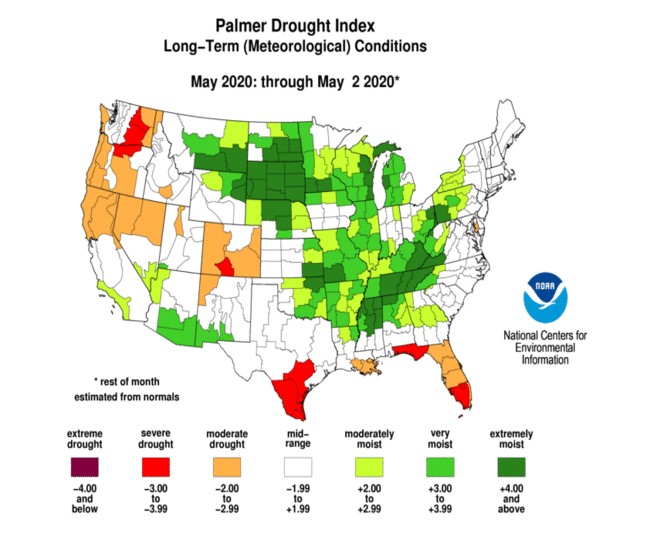The Los Angeles Times has launched a new way to make money and gain leftists accolades from the false climate crisis: a new newsletter called “Boiling Point.” Sammy Roth, a Times energy reporter, opened a May 5 preview of the newsletter by telling quite a whopper – and providing no scientific evidence to back it up. Roth claimed, “Drought conditions in Northern California may prompt an early start to the 2020 wildfire season – and as Californians have learned in recent years, climate change is fueling more devastating droughts and fires.”
The National Oceanic and Atmospheric Administration (NOAA) does report, here and in the chart below, that Northern California is currently experiencing “moderate drought,” and is one of the few places in the country experiencing dryer than average conditions. At the same time, NOAA reports most of California is experiencing normal conditions, while Southern California is experiencing “moderately moist” conditions.

Hmmm… some areas are dry, some are moist, and most are normal. Must be a climate crisis!
In reality, as shown here and in the same NOAA graph above, only a small amount of the country is experiencing drought. Also, Climate at a Glance: Drought reports the United States is undergoing its longest period in recorded history without at least 40 percent of the country experiencing “very dry” conditions, with peaks in drought around 1978, 1954, 1930, and 1900 being much larger than what the U.S. experienced during any time in the 21st century or the late 20th century.
Just as compelling, Climate at a Glance: Drought reports that in 2017 and 2019, the United States registered its smallest percentage of land area experiencing drought in recorded history.
Even the United Nations Intergovernmental Panel on Climate Change acknowledges with “high confidence” that precipitation has increased over mid-latitude land areas of the Northern Hemisphere (including the United States) during the past 70 years, while IPCC has “low confidence” about any negative trends globally.
Since drought conditions are low, and drought is easily the single biggest climate factor regarding wildfires, it should come as no surprise that wildfires have not become more frequent or numerous in recent years. In the few regions that have experienced particularly severe wildfires, such as California and Australia, geologist Gregory Wrightstone and Montana state Sen. Jennifer Fielder explain that the root cause of these fires is government policies hampering proper land management in areas prone to wildfires.
Perhaps all this good news and scientific evidence are why Roth and the Times are required to make false statements, without presenting scientific evidence, in order to perpetuate their money-making climate scare.

















I’m always interested to hear Californians, in particular, spout nonsense about climate change and forest fires. There are entire ecosystems in California, including in particular that of the Giant Sequoia, which have evolved to depend on fire; the sequoias are themselves fire-resistant and need fire to open their cones and also to clear the undergrowth so that their seeds have a better chance of growing. The state forestry department even has a pamphlet about the relations between sequoias and fire. And these trees evolved long before humans were on the scene (after all, some individual sequoias are over 2,000 years old), so how does human-caused climate change enter into it?
There is evidence of humans on the American continent dating 14,000 years ago
and some think even longer than that, but little evidence to support it. Native Indians used fire to clear underbrush and fuel load for 100’s probably 1000’s of years before Europeans arrived. But I do get what you are pointing out. California has created the disaster they are currently in and need a scapegoat to direct attention away from their failed ideas and policies.
” Roth claimed, “Drought conditions in Northern California may prompt an early start to the 2020 wildfire season – and as Californians have learned in recent years, climate change is fueling more devastating droughts and fires.”
Well, he didn’t actually say anthropogenic climate change. But that is a constant. We should lead the way, and when discussing/debating, we should distinguish between naturally occurring CC and man-made CC (if there is really any of note). When someone asks me about CC, my first question back to them, is along the lines of, ‘what are you speaking of?’
PS – his work is most always way out there in la la land.
Great piece, Sterling! Sammy Roth is a joke, an enviro activist posing as a journalist. They couldn’t find a real scientist or journalist willing to parrot the left’s lines on environment and energy, so they settled for him.
Excellent piece! The NOAA data corroborate the IPCC finding and show that the Palmer Drought Severity Index has trended higher in the U.S.(+.05 per decade) since 1895. In other words, conditions in the U.S. have actually become wetter, not drier, over the past 125 years!
I’d hope to see this sort of work presented at the upcoming Climate Change Conference in Las Vegas.
Climate alarmists take any negative event handy and attribute it to anthropogenic climate change. If there are floods in the Midwest or tornados in Mississippi, they must be caused by ACC. They seldom bother to offer any evidence but call climate realists “deniers.”
Good report and I have just completed a similar commentary on the subject here: https://inconvenientfacts.xyz/blog/f/mega-drought-or-mega-propaganda